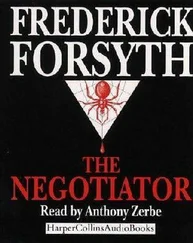Frederick Forsyth - The Devil's Alternative
Здесь есть возможность читать онлайн «Frederick Forsyth - The Devil's Alternative» весь текст электронной книги совершенно бесплатно (целиком полную версию без сокращений). В некоторых случаях можно слушать аудио, скачать через торрент в формате fb2 и присутствует краткое содержание. Жанр: Шпионский детектив, на английском языке. Описание произведения, (предисловие) а так же отзывы посетителей доступны на портале библиотеки ЛибКат.
- Название:The Devil's Alternative
- Автор:
- Жанр:
- Год:неизвестен
- ISBN:нет данных
- Рейтинг книги:5 / 5. Голосов: 1
-
Избранное:Добавить в избранное
- Отзывы:
-
Ваша оценка:
- 100
- 1
- 2
- 3
- 4
- 5
The Devil's Alternative: краткое содержание, описание и аннотация
Предлагаем к чтению аннотацию, описание, краткое содержание или предисловие (зависит от того, что написал сам автор книги «The Devil's Alternative»). Если вы не нашли необходимую информацию о книге — напишите в комментариях, мы постараемся отыскать её.
The Devil's Alternative — читать онлайн бесплатно полную книгу (весь текст) целиком
Ниже представлен текст книги, разбитый по страницам. Система сохранения места последней прочитанной страницы, позволяет с удобством читать онлайн бесплатно книгу «The Devil's Alternative», без необходимости каждый раз заново искать на чём Вы остановились. Поставьте закладку, и сможете в любой момент перейти на страницу, на которой закончили чтение.
Интервал:
Закладка:
While the Freya closed down her systems during the afternoon, the group would come back by cavalcade of limousines to central Rotterdam, forty kilometers up the river, for an evening reception. A press conference would precede this, during which Wennerstrom would present Thor Larsen to the world’s press.
Already, he knew, newspapers and television had leased helicopters to give the last few miles of the Freya and her berthing complete camera coverage.
Harry Wennerstrom was a contented old man.
By the early hours of March 30 the Freya was well through the channel between the Orkneys and the Shetlands. She had turned south, heading down the North Sea. As soon as she entered the crowded lanes of the North Sea, the Freya had reported in, contacting the first of the shore-based area traffic-control officers at Wick on the coast of Caithness in the far north of Scotland.
Because of her size and draft, she was a “hampered vessel.” She had reduced speed to ten knots and was following the instructions fed to her from Wick by VHF radiotelephone. All around her, unseen, the various control centers had her marked on their high-definition radars, manned by qualified pilot operators. These centers are equipped with computerized support systems capable of rapid assimilation of weather, tide, and traffic-density information.
Ahead of the Freya as she crawled down the southbound traffic lane, smaller ships were crisply informed to get out of her way. At midnight she passed Flamborough Head on the coast of Yorkshire, now moving farther east, away from the British coast and toward Holland. Throughout her passage she had followed the deepwater channel, a minimum of twenty fathoms. On her bridge, despite the constant instructions from ashore, her officers watched the echo-sounder readings, observing the banks and sandbars that make up the floor of the North Sea slide past on either side of her.
Just before sundown of March 31, at a point exactly fifteen sea miles due east of the Outer Gabbard Light, now down to her bare steerage speed of five knots, the giant swung gently eastward and moved to her overnight position, the deep-draft anchorage located at fifty-two degrees north. She was twenty-seven sea miles due west of the Maas Estuary, twenty-seven miles from home and glory.
It was midnight in Moscow. Adam Munro had decided to walk home from the diplomatic reception at the embassy. He had been driven there by the commercial counselor, so his own car was parked by his flat off Kutuzovsky Prospekt.
Halfway over the Serafimov Bridge, he paused to gaze down at the Moscow River. To his right he could see the illuminated cream-and-white stucco facade of the embassy; to his left the dark red walls of the Kremlin loomed above him, and above them the upper floor and dome of the Great Kremlin Palace.
It had been roughly ten months since he had flown from London to take up his new appointment. In that time he had pulled off the greatest espionage coup for decades, running the only spy the West had ever operated inside the heart of the Kremlin. They would savage him for breaking training, for not telling them all along who she was, but they could not diminish the value of what he had brought out.
Three weeks more and she would be out of this place, safe In London. He would be out, too, resigning from the service to start a new life somewhere else with the only person in the world he loved, ever had loved, or ever would.
He would be glad to leave Moscow, with its secrecy, its endless furtiveness, its mind-numbing drabness. In ten days the Americans would have their arms-reduction treaty, the Kremlin its grain and technology, the service its thanks and gratitude from Downing Street and the White House alike. A week more and he would have his wife-to-be, and she her freedom. He shrugged deeper into his thick, fur-collared coat and walked on across the bridge.
Midnight in Moscow is ten P.M. in the North Sea. By 2200 hours the Freya was motionless at last. She had steamed 7,085 miles from Chita to Abu Dhabi and a further 12,015 miles from there to where she now lay. She lay motionless along the line of the tide; from her stem a single anchor chain streamed out and down to the seabed, with five shackles on deck. Each link of the chain needed to hold her was nearly a yard long, and the steel thicker than a man’s thigh.
Because of her “hampered” state, Captain Larsen had brought her down from the Orkneys himself, with two navigating officers to assist him, as well as the helmsman. Even at the overnight anchorage he left his first officer, Stig Lundquist, his third mate, Tom Keller (a Danish-American), and an able seaman on the bridge through the night. The officers would maintain constant anchor watch; the seaman would carry out periodic deck inspection.
Though the Freya’s engines were closed down, her turbines and generators hummed rhythmically, churning out the power to keep her systems functioning.
Among these were constant input of tide and weather, of which the latest reports were heartening.
He could have had March gales; instead, an unseasonal area of high pressure almost stationary over the North Sea and the English Channel had brought a mild early spring to the coasts. The sea was almost a flat calm; a one-knot tide ran northeastward from the vessel toward the West Frisians. The sky had been a near-cloudless blue all day, and despite a touch of frost that night, bade fair to be so again on the morrow.
Bidding his officers goodnight, Captain Larsen left the bridge and descended one floor to D deck. Here, on the extreme starboard side, he had his suite. The spacious and well-appointed day cabin carried four windows looking forward down the length of the vessel, and two looking out to starboard. Aft of the day cabin were his bedroom and bathroom. The sleeping cabin also had two windows, both to starboard. All the windows were sealed, save one in the day cabin that was closed but with screw bolts that could be manually undone.
Outside his sealed windows to forward, the facade of the superstructure fell sheer to the deck; to starboard the windows gave onto ten feet of steel landing, beyond which was the starboard rail, and beyond it the sea. Five flights of steel ladders ran from the lowest A deck up five floors to the bridge-wing above his head, each stage of the ladders debouching onto a steel landing. All these sets of ladders and landings were open to the sky, exposed to the elements. They were seldom used, for the interior stairwells were heated and warm.
Thor Larsen lifted the napkin off the plate of chicken and salad the chief steward had left him, looked longingly at the bottle of Scotch in his liquor cabinet, and settled for coffee from the percolator. After eating he decided to work the night away on a final run-through of the channel charts for the morning’s berthing. It was going to be tight, and he wanted to know that channel as well as the two Dutch pilots who would arrive by helicopter from Amsterdam’s Schiphol Airport at seven-thirty to take her over. Prior to that, he knew, a gang of ten men from ashore, the extra hands, called “riggers,” who were needed for the berthing operation, would arrive by launch at 0700.
As midnight struck, he settled at the broad table in his day cabin, spread his charts, and began to study.
At ten minutes before three in the morning, it was frosty but clear outside. A half-moon caused the rippling sea to glitter. Inside the bridge Stig Lundquist and Tom Keller shared a companionable mug of coffee. The able seaman prowled the flowing screens along the bridge console.
“Sir,” he called, “there’s a launch approaching.”
Tom Keller rose and crossed to where the seaman pointed at the radar screen. There were a score of blips—some stationary, some moving, but all well away from the Freya . One tiny blip seemed to be approaching from the southeast.
Читать дальшеИнтервал:
Закладка:
Похожие книги на «The Devil's Alternative»
Представляем Вашему вниманию похожие книги на «The Devil's Alternative» списком для выбора. Мы отобрали схожую по названию и смыслу литературу в надежде предоставить читателям больше вариантов отыскать новые, интересные, ещё непрочитанные произведения.
Обсуждение, отзывы о книге «The Devil's Alternative» и просто собственные мнения читателей. Оставьте ваши комментарии, напишите, что Вы думаете о произведении, его смысле или главных героях. Укажите что конкретно понравилось, а что нет, и почему Вы так считаете.










